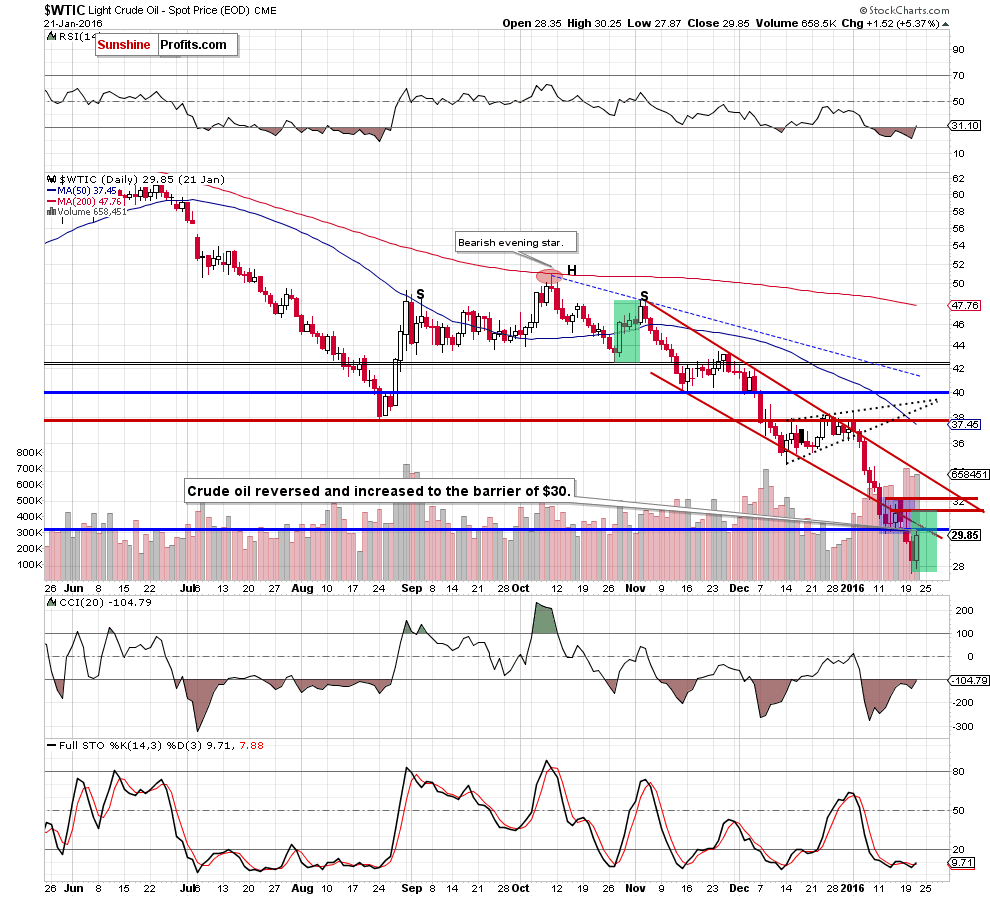Trading position (short-term; our opinion): Short positions (with a stop-loss order at $33.23 and the price target at $25.63) are justified from the risk/reward perspective.
Although EIA showed in its weekly report another increase in crude oil and gasoline inventories, the commodity reversed and climbed to the barrier of $30. Earlier today, light crude extended gains, hitting an intraday high above $31. Does it mean that the final bottom already in?
Yesterday, the Energy Information Agency reported that U.S. crude oil inventories increased by 4.0 million barrels for the week ending on January 15, significantly above forecasts for a 2.8 million build. On top of that, crude production rose to 9.235 million barrels per day last week, which was its seventh consecutive weekly increase. Additionally, gasoline inventories increased by 4.6 million barrels and reached its highest level since 1990. Despite these bearish numbers, crude oil bounced off session’s low and increased to the barrier of $30. Earlier today, light crude extended gains and moved above $31 as cold U.S. weather fuelled hopes for higher crude oil demand. Does it mean that the final bottom already in? Let’s examine charts and find out (charts courtesy of http://stockcharts.com).

Looking at the daily chart, we see that crude oil rebounded after a drop to our first downside target. With yesterday’s upswing the commodity climbed above the barrier of $30, but then gave up some gains and closed the day slightly below it. From yesterday’s perspective, such price action looks like a verification of earlier breakdown. Nevertheless, despite this price action, light crude extended gains and invalidated the breakdown not only below the barrier of $30 but also the lower border of the red declining trend channel earlier today. Although this is a positive signal, which suggests further improvement, we should keep in mind that as long as the current corrective upswing is smaller than the move, which we saw at the turn of Oct and Nov, the downtrend remains in place, suggesting lower values of the commodity.
Summing up, crude oil reversed and increased above the barrier of $30. Despite this improvement, we believe that as long as the current corrective upswing is smaller than the move, which we saw at the turn of Oct and Nov, the downtrend remains in place, suggesting lower values of the commodity. Therefore, in our opinion, short positions with a stop-loss order at $33.23 and the price target at $25.63 are still justified from the risk/reward perspective.
Very short-term outlook: bearish
Short-term outlook: bearish
MT outlook: bearish
LT outlook: mixed with bearish bias
Trading position (short-term; our opinion): Short positions (with a stop-loss order at $33.23 and the price target at $25.63) are justified from the risk/reward perspective. The analogous levels for USO ETF and DWTI ETN are:
- USO initial target price: $6.67; USO stop-loss: $9.91.
- DWTI initial target price: $513.31; DWTI stop-loss: $302.46.
We will keep you – our subscribers – informed should anything change.
As a reminder – “initial target price” means exactly that – an “initial” one, it’s not a price level at which we suggest closing positions. If this becomes the case (like it did in the previous trade) we will refer to these levels as levels of exit orders (exactly as we’ve done previously). Stop-loss levels, however, are naturally not “initial”, but something that, in our opinion, might be entered as an order.
Since it is impossible to synchronize target prices and stop-loss levels for all the ETFs and ETNs with the main market that we provide this level for (crude oil), the stop-loss level and target price for popular ETN and ETF (among other: USO, DWTI, UWTI) are provided as supplementary, and not as “final”. This means that if a stop-loss or a target level is reached for any of the “additional instruments” (DWTI for instance), but not for the “main instrument” (crude oil in this case), we will view positions in both crude oil and DWTI as still open and the stop-loss for DWTI would have to be moved lower. On the other hand, if crude oil moves to a stop-loss level but DWTI doesn’t, then we will view both positions (in crude oil and DWTI) as closed. In other words, since it’s not possible to be 100% certain that each related instrument moves to a given level when the underlying instrument does, we can’t provide levels that would be binding. The levels that we do provide are our best estimate of the levels that will correspond to the levels in the underlying assets, but it will be the underlying assets that one will need to focus on regarding the sings pointing to closing a given position or keeping it open. We might adjust the levels in the “additional instruments” without adjusting the levels in the “main instruments”, which will simply mean that we have improved our estimation of these levels, not that we changed our outlook on the markets.
Thank you.
Nadia Simmons
Forex & Oil Trading Strategist
Przemyslaw Radomski, CFA
Founder, Editor-in-chief
Gold & Silver Trading Alerts
Forex Trading Alerts
Oil Investment Updates
Oil Trading Alerts



